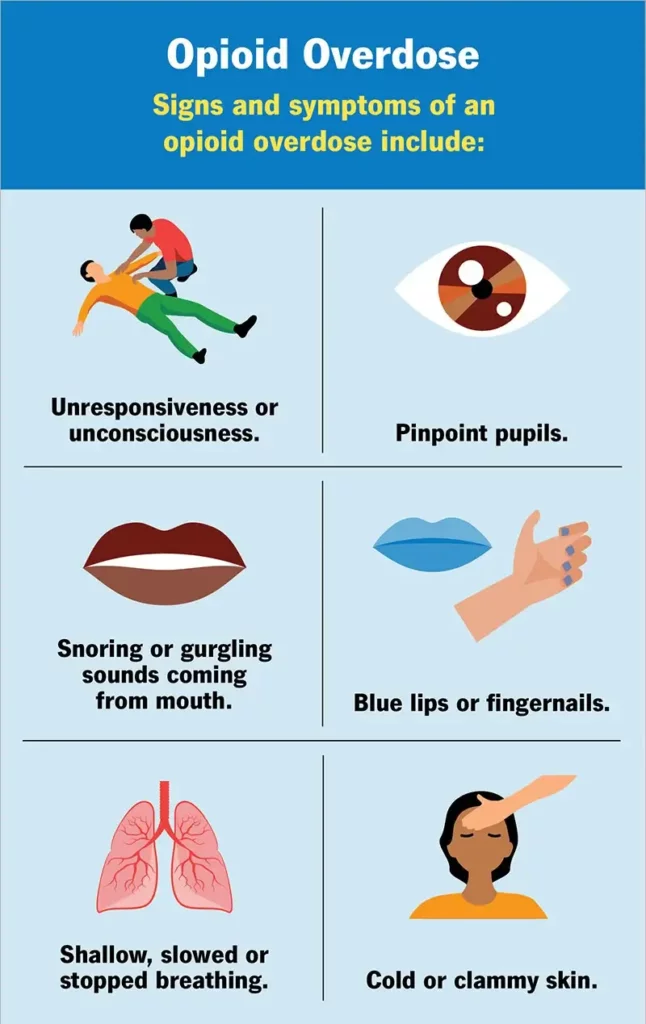Harm Reduction is a set of practical strategies and ideas aimed at decreasing negative consequences associated with drug use. Harm Reduction is also a movement for social justice built on a belief in, and respect for, the rights of people who use drugs.
Narcan is a potentially life saving medication designed to help reverse the effects of an opioid overdose in minutes Available as an intranasal spray or as an intramuscular injection.
Symptoms may or may not include & are not limited to: Vomiting/gurgling noises, nausea, drowsiness, extreme weakness, confusion, unconscious/unresponsive, unable to speak, slowed breathing, slowed heart rate, erratic pulse, small pupils, chest pains, pale/clammy skin, low body temp, lips & fingernails turning blue, limp body, vision issues, dulled reflexes, & seizures.

Step 1: Check response. Tap their shoulder & if you do not gain a response, pinch their ear lobe or fingertip. Try to gain their attention. Shout their name, shout “Wake up!”, ask them questions (“What is your name?” “Do you know where we are?” etc). If you still do not gain a response, call 911 & continue the next steps.
Step 2: Roll the individual on their back & lift their chin. This will clear their airway & allow easier breathing.
Step 3: Open your Narcan packaging & remove 1 of the 2 nasal sprays. Insert the nasal spray into their nostril until your fingers touch the edges of their nostril. Push the plunger & release the full dose.
Step 4: Roll the person onto their side & wait 2-3 minutes for the Narcan to take effect. You may now also rub their sternum, provide CPR and/or mouth to mouth. Keep in mind that the individual may wake up startled & frightened. They may be agitated & violent.
Step 5: If they do not wake up within 2-3 minutes of the initial Narcan dose, repeat steps 2-4. This time, administer the 2nd nasal spray into the other nostril. Wait another 3-4 minutes for the Narcan to take effect. You may continue CPR throughout steps 4 & 5. Hopefully, by this time extra help will have arrived. If not, a third dose of Narcan may be necessary, if available.
Step 1: Check response. Tap their shoulder & if you do not gain a response, pinch their ear lobe or fingertip. Try to gain their attention. Shout their name, shout “Wake up!”, ask them questions (“What is your name?” “Do you know where we are?” etc). If you still do not gain a response, call 911 & continue the next steps.
Step 2: If you have an alcohol pad, clean the injection site (arm, thigh, OR butt) UNLESS you are administering on the tongue.
Step 3: Remove the caps from the naloxone & the needle. Turn the naloxone upside down and insert the needle. Draw back on the syringe to extract the naloxone until full/1 ml.
Step 4: Inject the full 1 ml dose into the arm, thigh, or butt (or tongue if using an intravenous needle). You may administer through clothing.
Step 5: Roll the person onto their side & wait 2-3 minutes for the Narcan to take effect. You may now also provide CPR. Keep in mind that the individual may wake up startled & frightened. They may be agitated & violent. Intramuscular injections are often painful as well.
Step 6: If they do not wake up within 2-3 minutes of the initial naloxone dose, repeat steps 2-5. Wait another 3-4 minutes for the naloxone to take effect. You may continue CPR throughout steps 5 & 6.
Hopefully, by this time extra help will have arrived. If not, a third dose of naloxone may be necessary, if available.
Contrary to popular belief, it is possible to experience withdrawal after using cannabis daily for a long time. Withdrawal typically manifests as insomnia, appetite changes, anxiety, or irritability. Cannabis withdrawal is never life-threatening and is rarely anything more than a nuisance for a few days or weeks.
People who suffer from depression and lack of energy, or who have very demanding high-stress lives, may be more vulnerable to developing a problematic relationship with meth
Many of the stereotypical meth-related consequences like “meth mouth” are actually a product of dry mouth and poor oral hygiene, although smoking meth can cause enamel decay.